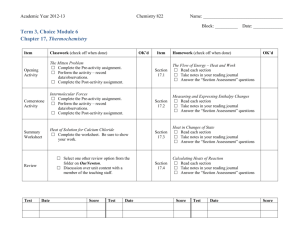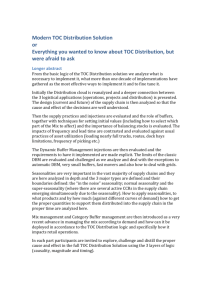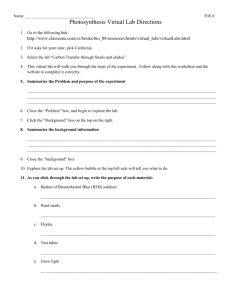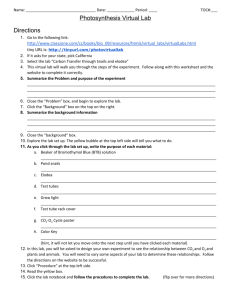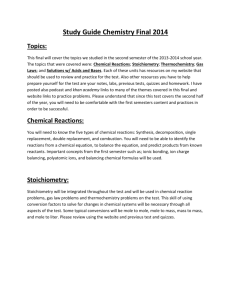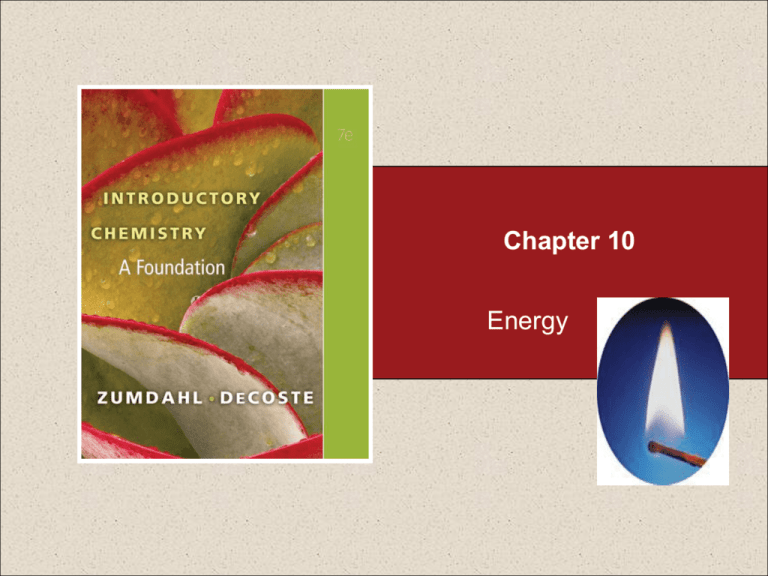
Chapter 10
Energy
Chapter 10
Table of Contents
10.1
10.2
10.3
10.4
10.5
10.6
10.7
10.8
10.9
10.10
The Nature of Energy
Temperature and Heat
Exothermic and Endothermic Processes
Thermodynamics
Measuring Energy Changes
Thermochemistry (Enthalpy)
Hess’s Law
Quality Versus Quantity of Energy
Energy and Our World
Energy as a Driving Force
Copyright © Cengage Learning. All rights reserved
2
Section 10.1
The Nature of Energy
Energy
•
•
Ability to do work or produce heat.
That which is needed to oppose natural
attractions.
• Law of conservation of energy – energy
can be converted from one form to
another but can be neither created nor
destroyed.
The total energy content of the universe
is constant.
Return to TOC
Copyright © Cengage Learning. All rights reserved
3
Section 10.1
The Nature of Energy
Energy
•
•
Potential energy – energy due to position
or composition.
Kinetic energy – energy due to motion of
the object and depends on the mass of
the object and its velocity.
Telekinesis Video
Return to TOC
4
Section 10.1
The Nature of Energy
Energy Transformations
Types of Energy
1. Kinetic energy
2. Potential energy
3. Chemical energy
4. Heat energy
5. Electric energy
6. Radiant energy
Return to TOC
5
Section 10.1
The Nature of Energy
Initial Position
•
In the initial position, ball A has a higher
potential energy than ball B.
Return to TOC
6
Section 10.1
The Nature of Energy
Final Position
•
After A has rolled down the hill, the potential
energy lost by A has been converted to random
motions of the components of the hill (frictional
heating) and to the increase in the potential
energy of B.
Return to TOC
7
Section 10.1
The Nature of Energy
Temperature = average kinetic energy.
Heat= total energy.
Both of the above are at 70oF. Which has the
most heat?
Return to TOC
8
Section 10.2
Temperature and Heat
Temperature
•
A measure of the random motions of the components
of a substance.
Return to TOC
Copyright © Cengage Learning. All rights reserved
9
Section 10.2
Temperature and Heat
Heat
•
A flow of energy between two objects due to a
temperature difference between the objects.
Heat is the way in which thermal energy is
transferred from a hot object to a colder object.
Return to TOC
Copyright © Cengage Learning. All rights reserved
10
Section 10.3
Exothermic and Endothermic Processes
Energy Changes Accompanying the Burning of a Match
Return to TOC
Copyright © Cengage Learning. All rights reserved
11
Section 10.3
Exothermic and Endothermic Processes
Energy Changes and Chemical Reactions
4 C3H5N3O9 6 N2 + 10 H2O + 12 CO2 + O2 + 5720kJ
Nitroglycerine
Exothermic
Return to TOC
12
Section 10.3
Exothermic and Endothermic Processes
•
Endothermic Process:
Heat flow is into a system.
Absorb energy from the
surroundings. q = positive(+)
• Exothermic Process:
Energy flows out of the
system. q = negative (-)
• Energy gained by the surroundings must
be equal to the energy lost by the system.
Return to TOC
13
Section 10.3
Exothermic and Endothermic Processes
Concept Check
Is the freezing of water an endothermic or
exothermic process? Explain.
Return to TOC
Copyright © Cengage Learning. All rights reserved
14
Section 10.3
Exothermic and Endothermic Processes
Concept Check
Classify each process as exothermic or
endothermic. Explain. The system is
underlined in each example.
Exo
a)
Endo
Endo
b)
c)
Exo
Endo
d)
e)
Your hand gets cold when you touch
ice.
The ice gets warmer when you touch it.
Water boils in a kettle being heated on a
stove.
Water vapor condenses on a cold pipe.
Ice cream melts.
Return to TOC
Copyright © Cengage Learning. All rights reserved
15
Section 10.3
Exothermic and Endothermic Processes
Concept Check
For each of the following, define a system
and its surroundings and give the direction
of energy transfer.
a)
b)
Methane is burning in a Bunsen burner in a
laboratory. System=burner, surroundings= lab, energy to system
Water drops, sitting on your skin after
swimming, evaporate.
System=drops, surroundings= air, energy to surroundings
Return to TOC
Copyright © Cengage Learning. All rights reserved
16
Section 10.3
Exothermic and Endothermic Processes
Concept Check
Hydrogen gas and oxygen gas react
violently to form water.
Which is lower in energy: a mixture
of hydrogen and oxygen gases, or
water? Explain.
Return to TOC
Copyright © Cengage Learning. All rights reserved
17
Section 10.4
Thermodynamics
•
•
Study of energy
Law of conservation of energy is often
called the first law of thermodynamics.
The energy of the universe is constant.
Return to TOC
18
Section 10.5
Measuring Energy Changes
•
The common energy units for heat are the
calorie and the joule.
calorie – the amount of energy (heat)
required to raise the temperature of one
gram of water 1oC.
Joule – 1 calorie = 4.184 joules
Return to TOC
19
Section 10.5
Measuring Energy Changes
Example
Convert 60.1 cal to joules.
60.1 cal
4.184 J
= 251 J
1 cal
Return to TOC
20
Section 10.5
Measuring Energy Changes
Energy (Heat) Required to Change the Temperature of a
Substance Depends On:
1. The amount of substance being heated
(number of grams).
2. The temperature change (number of
degrees).
3. The identity of the substance.
Specific heat capacity is the energy required
to change the temperature of a mass of one
gram of a substance by one Celsius degree.
Return to TOC
Copyright © Cengage Learning. All rights reserved
21
Section 10.5
Measuring Energy Changes
Specific Heat Capacities of Some Common Substances
Return to TOC
Copyright © Cengage Learning. All rights reserved
22
Section 10.5
Measuring Energy Changes
To Calculate the Energy Required for a Reaction:
• Energy (heat) required, Q = s × m × ΔT
Since q=ΔH (change of heat) ΔH = s x m x ΔT
Q = energy (heat) required (J)
s = specific heat capacity (J/°C·g)
m = mass (g)
ΔT = change in temperature (°C)
Return to TOC
Copyright © Cengage Learning. All rights reserved
23
Section 10.5
Measuring Energy Changes
Energy of a Snickers Bar
There are 311 Cal in a Snickers Bar. If you added this much
heat to a gallon of water at 25oC what would be the final
temperature?
311 Cal = 311,000 cal
1 gallon of water weighs 3960.4 g
Heat = SH x m x ΔT
311,000 cal = 1.000 cal/goC x 3960.4g x ?oC
Solving for the change of temperature gives us 78.5oC
Add this to the 25oC to get 104oC which is above the
boiling point of water (100oC)
Return to TOC
24
Section 10.5
Measuring Energy Changes
Example
Calculate the amount of heat energy (in
joules) needed to raise the temperature of
6.25 g of water from 21.0°C to 39.0°C.
Where are we going?
• We want to determine the amount of energy
needed to increase the temperature of 6.25 g of
water from 21.0°C to 39.0°C.
What do we know?
• The mass of water and the temperature increase.
Return to TOC
Copyright © Cengage Learning. All rights reserved
25
Section 10.5
Measuring Energy Changes
Example
Calculate the amount of heat energy (in
joules) needed to raise the temperature of
6.25 g of water from 21.0°C to 39.0°C.
What information do we need?
• We need the specific heat capacity of water.
4.184 J/g°C
How do we get there?
Q = s m T
Q = 4.184 J/g C 6.25 g 39.0 C 21.0 C
Q = 471 J
Copyright © Cengage Learning. All rights reserved
Return to TOC
26
Section 10.5
Measuring Energy Changes
Exercise
A sample of pure iron requires 142 cal of energy to raise its
temperature from 23ºC to 92ºC. What is the mass of the sample?
(The specific heat capacity of iron is 0.45 J/gºC.)
a)
b)
c)
d)
0.052 g
4.6 g
19 g
590 g
Q = s m T
m=
Q
s T
142 cal
4.184 J
1 cal
m=
= 19 g
0.45 J/g C 92 C 23 C
Return to TOC
27
Section 10.5
Measuring Energy Changes
Concept Check
A 100.0 g sample of water at 90.°C is added to a
500.0 g sample of water at 10.°C.
The final temperature of the water is:
a) Between 50°C and 90°C
b) 50°C
c) Between 10°C and 50°C
Calculate the final temperature of the water.
(90o(100g)+ 10o(500g))/600gT = 23o
Return to TOC
28
Section 10.5
Measuring Energy Changes
Concept Check
You have a Styrofoam cup with 50.0 g of water at
10.C. You add a 50.0 g iron ball at 90.C to the
water. (sH2O = 4.18 J/°C·g and sFe = 0.45 J/°C·g)
The final temperature of the water is:
a) Between 50°C and 90°C
b) 50°C
c) Between 10°C and 50°C
Calculate the final temperature of the water. 18°C
50.0gFe(0.45SHFe)(90-XoC)=50.0gw(4.18SHw)(X-10oC)
Return to TOC
29
Section 10.6
Thermochemistry (Enthalpy)
Example
Consider the reaction:
S(s) + O2(g) → SO2(g)
ΔH = –296 kJ per mole of SO2 formed. Calculate
the quantity of heat released when 2.10 g of sulfur
is burned in oxygen at constant pressure.
Where are we going?
•
We want to determine ΔH for the reaction of 2.10 g of
S with oxygen at constant pressure.
What do we know?
•
•
When 1 mol SO2 is formed, –296 kJ of energy is
released.
We have 2.10 g S.
Copyright © Cengage Learning. All rights reserved
Return to TOC
30
Section 10.6
Thermochemistry (Enthalpy)
Example
Consider the reaction:
S(s) + O2(g) → SO2(g)
ΔH = –296 kJ per mole of SO2 formed. Calculate
the quantity of heat released when 2.10 g of sulfur
is burned in oxygen at constant pressure.
How do we get there?
1 mol S
2.10 g S
= 0.0655 mol S
32.06 g S
1 mol SO2
296 kJ
0.0655 mol S
= 19.4 kJ
1 mol S
1 mol SO 2
Return to TOC
Copyright © Cengage Learning. All rights reserved
31
Section 10.6
Thermochemistry (Enthalpy)
Exercise
Consider the combustion of propane:
C3H8(g) + 5O2(g) → 3CO2(g) + 4H2O(l)
ΔH = –2221 kJ
Assume that all of the heat comes from the combustion of
propane. Calculate ΔH in which 5.00 g of propane is burned
in excess oxygen at constant pressure.
–252 kJ
5.00 g C3H8
1 mol C3H8
2221 kJ
44.094 g C3H8
1 mol C3H8
Return to TOC
32
Section 10.6
Thermochemistry (Enthalpy)
Calorimetry
•
Enthalpy, H is
measured using a
calorimeter.
Return to TOC
33
Section 10.6
Thermochemistry (Enthalpy)
•
In going from a particular set of reactants to a
particular set of products, the change in
enthalpy is the same whether the reaction
takes place in one step or in a series of steps.
Return to TOC
34
Section 10.6
Thermochemistry (Enthalpy)
N2(g) + 2O2(g) → 2NO2(g)
•
ΔH1 = 68 kJ
This reaction also can be carried out in
two distinct steps, with enthalpy changes
designated by ΔH2 and ΔH3.
N2(g) + O2(g) → 2NO(g)
2NO(g) + O2(g) → 2NO2(g)
N2(g) + 2O2(g) → 2NO2(g)
ΔH2 = 180 kJ
ΔH3 = – 112 kJ
ΔH2 + ΔH3 = 68 kJ
ΔH1 = ΔH2 + ΔH3 = 68 kJ
Return to TOC
Copyright © Cengage Learning. All rights reserved
35
Section 10.6
Thermochemistry (Enthalpy)
Characteristics of Enthalpy Changes
•
•
If a reaction is reversed, the sign of ΔH is
also reversed.
The magnitude of ΔH is directly
proportional to the quantities of reactants
and products in a reaction. If the
coefficients in a balanced reaction are
multiplied by an integer, the value of ΔH is
multiplied by the same integer.
Return to TOC
Copyright © Cengage Learning. All rights reserved
36
Section 10.6
Thermochemistry (Enthalpy)
Example
•
•
Consider the following data:
1
3
2
2
NH3 (g )
N2 ( g ) H2 ( g )
H = 46 kJ
2 H2 ( g ) O2 ( g )
2 H2O( g )
H = 484 kJ
Calculate ΔH for the reaction
2 N2 (g ) 6 H2O(g )
3 O2 ( g ) 4 NH3 ( g )
Return to TOC
Copyright © Cengage Learning. All rights reserved
37
Section 10.6
Thermochemistry (Enthalpy)
Problem-Solving Strategy
•
•
•
Work backward from the required
reaction, using the reactants and products
to decide how to manipulate the other
given reactions at your disposal.
Reverse any reactions as needed to give
the required reactants and products.
Multiply reactions to give the correct
numbers of reactants and products.
Return to TOC
Copyright © Cengage Learning. All rights reserved
38
Section 10.6
Thermochemistry (Enthalpy)
Example
•
Reverse the two reactions:
1
H = 46 kJ
2 H2O( g )
2 H2 ( g ) O2 ( g )
H = +484 kJ
2
•
3
N2 (g ) H2 ( g )
NH3 ( g )
2
Desired reaction:
2 N2 (g ) 6 H2O(g )
3 O2 ( g ) 4 NH3 ( g )
Return to TOC
Copyright © Cengage Learning. All rights reserved
39
Section 10.6
Thermochemistry (Enthalpy)
Example
•
Multiply reactions to give the correct numbers
of reactants and products:
1
3
H = 46 kJ )
4( 2
4(
2
3( 2 H2O(g ) 2 H2 (g ) O2 (g )) 3(H = +484 kJ )
•
N2 (g ) H2 ( g )
NH3 ( g ) )
Desired reaction:
2 N2 (g ) 6 H2O(g )
3 O2 ( g ) 4 NH3 ( g )
Return to TOC
Copyright © Cengage Learning. All rights reserved
40
Section 10.6
Thermochemistry (Enthalpy)
Example
•
•
Final reactions:
2 N2 (g ) 6 H2 ( g )
4 NH3 ( g )
H = 184 kJ
6 H2O(g )
6 H2 ( g ) 3 O2 ( g )
H = +1452 kJ
Desired reaction:
2 N2 (g ) 6 H2O(g )
3 O2 ( g ) 4 NH3 ( g )
ΔH = +1268 kJ
Return to TOC
Copyright © Cengage Learning. All rights reserved
41
Section 10.6
Thermochemistry (Enthalpy)
Concept Check
Calculate ΔH for the reaction:
SO2 + ½O2 → SO3 ΔH = ?
(1) S + O2 → SO2
(2) 2S + 3O2 → 2SO3
Given:
a)
b)
c)
d)
–693 kJ
101 kJ
693 kJ
–99 kJ
ΔH = –297 kJ
ΔH = –792 kJ
Turn the first reaction around and
divide the second reaction by 2.
Do the same with the ΔH’s.
-792/2 + 297 = -99 kJ
Return to TOC
42
Section 10.6
Thermochemistry (Enthalpy)
Fossil Fuels
•
Carbon based molecules from decomposing plants
and animals
Energy source for United States
Return to TOC
Copyright © Cengage Learning. All rights reserved
43
Section 10.6
Thermochemistry (Enthalpy)
Petroleum
•
Thick liquids composed of mainly hydrocarbons.
Hydrocarbon – compound composed of C and H.
Return to TOC
Copyright © Cengage Learning. All rights reserved
44
Section 10.6
Thermochemistry (Enthalpy)
Natural Gas
•
Gas composed of hydrocarbons.
Return to TOC
Copyright © Cengage Learning. All rights reserved
45
Section 10.6
Thermochemistry (Enthalpy)
Coal
•
Formed from the remains of plants under high
pressure and heat over time.
Return to TOC
Copyright © Cengage Learning. All rights reserved
46
Section 10.6
Thermochemistry (Enthalpy)
Effects of Carbon Dioxide on Climate
•
Greenhouse Effect
Return to TOC
Copyright © Cengage Learning. All rights reserved
47
Section 10.6
Thermochemistry (Enthalpy)
Effects of Carbon Dioxide on Climate
•
Atmospheric CO2
Controlled by water cycle
Could increase temperature by 10oC
Return to TOC
48
Section 10.6
Thermochemistry (Enthalpy)
Global Warming
Return to TOC
Section 10.6
Thermochemistry (Enthalpy)
Global Warming
Return to TOC
Section 10.6
Thermochemistry (Enthalpy)
Global Warming
Return to TOC
Section 10.6
Thermochemistry (Enthalpy)
Global Warming
Return to TOC
Section 10.6
Thermochemistry (Enthalpy)
New Energy Sources
•
•
•
•
•
Solar
Nuclear
Biomass
Wind
Synthetic fuels
Return to TOC
53
Section 10.6
Thermochemistry (Enthalpy)
•
•
Natural processes occur in the direction that
leads to an increase in the disorder of the
universe.
Example
Consider a gas trapped as shown
Return to TOC
Copyright © Cengage Learning. All rights reserved
54
Section 10.6
Thermochemistry (Enthalpy)
•
What happens when the valve is opened?
Return to TOC
Copyright © Cengage Learning. All rights reserved
55
Section 10.6
Thermochemistry (Enthalpy)
Two Driving Forces
•
•
Energy spread
Matter spread
Gives off energy when
solid forms. Spreads
out when dissolves.
Return to TOC
Copyright © Cengage Learning. All rights reserved
56
Section 10.6
Thermochemistry (Enthalpy)
Energy Spread
•
In a given process concentrated energy is dispersed
widely.
•
This happens in every exothermic process.
Return to TOC
Copyright © Cengage Learning. All rights reserved
57
Section 10.6
Thermochemistry (Enthalpy)
Matter Spread
•
Molecules of a substance spread out to occupy a
larger volume.
•
Processes are favored if they involve energy and
matter spread.
Copyright © Cengage Learning. All rights reserved
Return to TOC
58
Section 10.6
Thermochemistry (Enthalpy)
Entropy, S
•
•
Function which keeps track of the tendency for the
components of the universe to become disordered.
Measure of disorder or randomness
Return to TOC
59
Section 10.6
Thermochemistry (Enthalpy)
Entropy, S
•
What happens to the disorder in the universe as
energy and matter spread?
Return to TOC
Copyright © Cengage Learning. All rights reserved
60
Section 10.6
Thermochemistry (Enthalpy)
Second Law of Thermodynamics
•
The entropy of the universe is always
increasing.
The heat death of the
universe will occur when From this
all particles of matter
ultimately have the same
average kinetic energy
and exist in a state of
maximum disorder.
To this
Return to TOC
61



